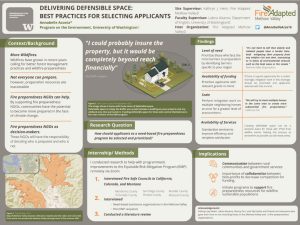Can’t Take the Heat? Create Defensible Space: Delivering Defensible Space to Wildfire Vulnerable Populations
With the ever-increasing impacts of climate change comes the need for preparation. Wildfires have grown in recent years calling for better forest management practices and wildfire preparedness, however, much of the preparation resources are inaccessible. By working to make these resources more accessible, communities have the potential to become more prepared in the face of climate change. The purpose of this study is to examine the best practices of delivering need-based defensible space assistance to wildfire impacted communities in need. I interned with Fire Adapted Methow Valley, a grassroots organization focused on making the Methow a Fire Adapted Community. Specifically, I worked on their Equitable Risk Mitigation Program, which plans to bring firewise assistance to those in need. I conducted interviews, literature reviews, and surveys to find the best methods of selecting and prioritizing applicants. Through this research, I found four main components that should go into the application selection process, the level of need of the applicant, the availability of related funding, having neighbors who are also in need of firsewise assistance, and the availability of services necessary to address the landscape need. Though there is more work that needs to be done to decrease the frequency and severity of the wildfire seasons we have seen in recent years, developing a robust, just, and efficient system of delivering firewise resources could mean the difference between saving or losing a home for most wildfire impacted communities.
